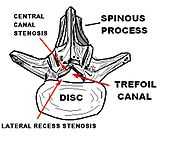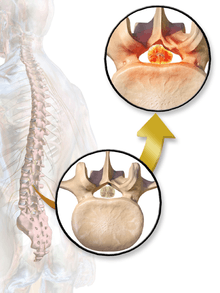Spinal stenosis
| Spinal stenosis | |
|---|---|
| Classification and external resources | |
 Lumbar trefoil canal | |
| MedlinePlus | 000441 |
Spinal stenosis is an abnormal narrowing (stenosis) of the spinal canal that may occur in any of the regions of the spine. This narrowing causes a restriction to the spinal canal, resulting in a neurological deficit. Symptoms include pain, numbness, paraesthesia, and loss of motor control. The location of the stenosis determines which area of the body is affected.[1] With spinal stenosis, the spinal canal is narrowed at the vertebral canal, which is a foramen between the vertebrae where the spinal cord (in the cervical or thoracic spine) or nerve roots (in the lumbar spine) pass through.[2] There are several types of spinal stenosis: lumbar stenosis and cervical stenosis being the most frequent. While lumbar spinal stenosis is more common, cervical spinal stenosis is more dangerous because it involves compression of the spinal cord whereas the lumbar spinal stenosis involves compression of the cauda equina.
Types
The most common forms are cervical spinal stenosis, at the level of the neck, and lumbar spinal stenosis, at the level of the lower back. Thoracic spinal stenosis, at the level of the mid-back, is much less common.[1]
In lumbar stenosis, the spinal nerve roots in the lower back are compressed which can lead to symptoms of sciatica (tingling, weakness, or numbness that radiates from the low back and into the buttocks and legs).
Cervical spinal stenosis can be far more dangerous by compressing the spinal cord. Cervical canal stenosis may lead to serious symptoms such as major body weakness and paralysis. Such severe spinal stenosis symptoms are virtually absent in lumbar stenosis, however, as the spinal cord terminates at the top end of the adult lumbar spine, with only nerve roots (cauda equina) continuing further down.[3] Cervical spinal stenosis is a condition involving narrowing of the spinal canal at the level of the neck. It is frequently due to chronic degeneration,[4] but may also be congenital or traumatic. Treatment frequently is surgical.[4]
Signs and symptoms

Common
- Standing discomfort (94%)
- Numbness (63%)
- Weakness (43%)
- Bilateral symptoms (68%)
- Discomfort above and below knee (78%)
- Buttock / Thigh only (15%)
- Below the knee (7%)[5]
- "Shopping cart sign"- need to grab a shopping cart when going into a store in order to hold onto the cart and bend over relieving the pain in the legs.
Neurological disorders
- Pinched nerve,[6] causing numbness.
- Intermittent neurogenic claudication [5][7][8] characterized by lower limb numbness, weakness, diffuse or radicular leg pain associated with paresthesis (bilaterally),[7] weakness heaviness in buttocks radiating into lower extremities with walking or prolonged standing.[5] Symptoms occur with extension of spine and are relieved with spine flexion. Minimal to zero symptoms when seated or supine.[5]
- Radiculopathy (with or without radicular pain) [7] neurologic condition - nerve root dysfunction causes objective signs such as weakness, loss of sensation and of reflex.
- Cauda equina syndrome [9] Lower extremity pain, weakness, numbness that may involve perineum and buttocks, associated with bladder and bowel dysfunction.
Other
- Fever
- Nocturnal pain
- Gait disturbance
- Structural deformity
- Unexplained weight loss
- Previous carcinoma
- Severe pain upon lying down
- Recent trauma with suspicious fracture
- Presence of severe or progressive neurologic deficit [9]
- Lower back pain [5][8] due to degenerative disc or joint changes [10]
- Narrowing of spinal canal, nerve root canal or intervertebral Canal Stenosis: Start with nonsurgical therapy. Cleveland ral foramina [8]
Causes
Aging: All the factors below may cause the spaces in the spine to narrow,
- Body’s ligaments can thicken (ligamentum flavum)
- Bone spurs develop on the bone and into the spinal canal
- Intervertebral discs may bulge or herniate into the canal
- Facet joints break down
- Compression fractures of the spine, which are common in osteoporosis
- Cysts form on the facet joints causing compression of the spinal sack of nerves (thecal sac)
Arthritis: Two types,
- Osteoarthritis
- Rheumatoid arthritis—much less common cause of spinal problems
Heredity:
- Spinal canal is too small at birth
- Structural deformities of the vertebrae may cause narrowing of the spinal canal
Instability of the spine, or spondylolisthesis:
- A vertebra slips forward on another
Trauma:
- Accidents and injuries may dislocate the spine and the spinal canal or cause burst fractures that yield fragments of bone that go through the canal [11]
Tumors of the spine:
- Irregular growths of soft tissue will cause inflammation
- Growth of tissue into the canal pressing on nerves, the sac of nerves, or the spinal cord.
Diagnosis
Making the diagnosis of spinal stenosis involves a complete evaluation of the spine. The process always begins with a medical history and physical
Medical history
The medical history is the most important aspect of the examination as it will tell the physician about subjective symptoms, possible causes for spinal stenosis, and other possible causes of back pain.[12]
Physical examination
The physical examination of a patient with spinal stenosis will give the physician information about exactly where nerve compression is occurring. Some important factors that should be investigated are any areas of sensory abnormalities, numbness, irregular reflexes, and any muscular weakness. [12]
MRI
The MRI has become the most frequently used study to diagnose spinal stenosis. The MRI uses magnetic signals (instead of x-rays) to produce images of the spine. MRIs are helpful because they show more structures, including nerves, muscles, and ligaments, than seen on x-rays or CT scans. MRIs are helpful at showing exactly what is causing spinal nerve compression.[12]
CT myelogram
A spinal tap is performed in the low back with dye injected into the spinal fluid. X-Rays are performed followed by a CT scan of the spine to help see narrowing of the spinal canal. This is a very effective study in cases of lateral recess stenosis. It is also necessary in patients with a pacemaker as they cannot undergo an MRI.
Treatments
Non-surgical treatment includes:
- Education about the course of the condition and how to relieve symptoms
- Medicines to relieve pain and inflammation, such as acetaminophen and nonsteroidal anti-inflammatory drugs (NSAIDs)
- Exercise, to maintain or achieve overall good health, aerobic exercise, especially riding a stationary bicycle, which allows for a forward lean, can relieve symptoms
- Weight loss, to relieve symptoms and slow progression of the stenosis
- Physical therapy, to provide education, instruction, and support for self-care; physical therapy instructs on stretching and strength exercises that may lead to a decrease in pain and other symptoms [13]
- Lumbar Epidural Steroid Injections - these may provide some temporary relief and sometimes work for a few years. If the stenosis is severe, these are not very beneficial.
Surgical Treatment:
- Lumbar Decompressive Laminectomy - Removing the roof of bone overlying the spinal canal and thickened ligaments in order to decompress the nerves and sac of nerves. This procedure is well tolerated in the hands of a skilled neurosurgeon or orthopedic spine trained surgeon. 96% of patients undergoing this procedure report "good results".[14]
Epidemiology
- Swedish study defined spinal stenosis as a canal of 11mm or less found an incidence of 5 per 100,000 inhabitants.[15]
- National Low Back Pain Study recorded that out of 2,374 patients with low back pain, 35% had bone related spinal nerve compression.
- Data from National Ambulatory Medical Care survey suggests 13-14% of patients with low back pain may have spinal stenosis.
- The NAMCS data shows the incidence in the U.S. population to be 3.9% of 29,964,894 visits for mechanical back problems.[16]
- The Longitudinal Framingham Heart Study found 1% of men and 1.5% of women had vertebral slippage at mean age of 54. Over the next 25 years, 11% of men and 25% of women developed degenerative vertebral slippage.[17]
- 250,000-500,000 U.S. residents have symptoms of spinal stenosis.
References
- ↑ 1.0 1.1 Vokshoor A (February 14, 2010). "Spinal Stenosis". eMedicine. Retrieved December 30, 2010.
- ↑ http://www.niams.nih.gov/Health_Info/Spinal_Stenosis/spinal_stenosis_ff.asp
- ↑ Waxman, SG (2000). Correlative Neuroanatomy (24th ed.).
- ↑ 4.0 4.1 Meyer F, Börm W, Thomé C (May 2008). "Degenerative cervical spinal stenosis: current strategies in diagnosis and treatment". Dtsch Arztebl Int 105 (20): 366–72. doi:10.3238/arztebl.2008.0366. PMC 2696878. PMID 19626174.
- ↑ 5.0 5.1 5.2 5.3 5.4 Mazanec, D.J., Podichetty, V.K., Hsia, A. (2002) Lumbar Canal Stenosis: Start with nonsurgical therapy. Cleveland Clinic Journal of Medicine 69(11).
- ↑ "Cervical Radiculopathy (Pinched Nerve)". AAOS. Retrieved 13 December 2011.
- ↑ 7.0 7.1 7.2 Costantini, A., Buchser, E., Van Buyten, J.P. (2009). Spinal Cord Stimulation for the Treatment of Chronic Pain in Patients with Lumbar Spinal Stenosis. Neuromodulation, 13(4), 275-380. doi:10.1111/j.1525-1403.2010.00289.x
- ↑ 8.0 8.1 8.2 Goren, A., Yildiz, N., Topuz, O., Findikoglu, G., & Ardic, F. (2010). Efficacy of exercise and ultrasound in patients with lumbar spinal stenosis: A prospective randomized controlled trial. Clinical Rehabilitation, 24(7), 623-631. doi:10.1177/0269215510367539
- ↑ 9.0 9.1 Doorly, T.P., Lambing, C.L., Malanga, G.A., Maurer, P.M., Ralph R., R. (2010). Algorithmic approach to the management of the patient with lumbar spinal stenosis. Journal of Family Practice, 59 S1-S8
- ↑ Mazanec, D.J., Podichetty, V.K., Hsia, A. (2002) LumbarClinic Journal of Medicine 69(11).
- ↑ http://www.mayoclinic.com/health/spinal-stenosis/DS00515/DSECTION=causes
- ↑ 12.0 12.1 12.2 Cluett, Jonathan, M.D. (2010) How is spinal stenosis diagnosed, spinal stenosis, http://orthopedics.about.com/cs/spinalstenosis/a/spinalstenosis_2.htm
- ↑ http://www.webmd.com/back-pain/tc/lumbar-spinal-stenosis-treatment-overview
- ↑ Greenburg, Mark (2010). Handbook of Neurosurgery 7th edition. New York: Thieme Publishing. p. 484. ISBN 978-1-60406-326-4.
- ↑ http://www.vancouverspinecarecentre.com/con_spinalstenosis
- ↑ Spinal Stenosis. (2011) In SpinalStenosis.org. Retrieved 2/29/12, from http://www.spinalstenosis.org/.
- ↑ Treatment of Degenerative Lumbar Spinal Stenosis: Summary of Evidence Report/Technology Assessment, No. 32. (2001). In AHRQ Archive--Home Page. Retrieved 2/29/2012, fromhttp://archive.ahrq.gov/clinic/epcsums/stenosum.htm.
External links
- http://www.uvm.edu/medicine/documents/CMS_Monsey_Spinal_Stenosis_Resources_101210.pdf
- http://www.ncbi.nlm.nih.gov/pubmedhealth/PMH0001477/
